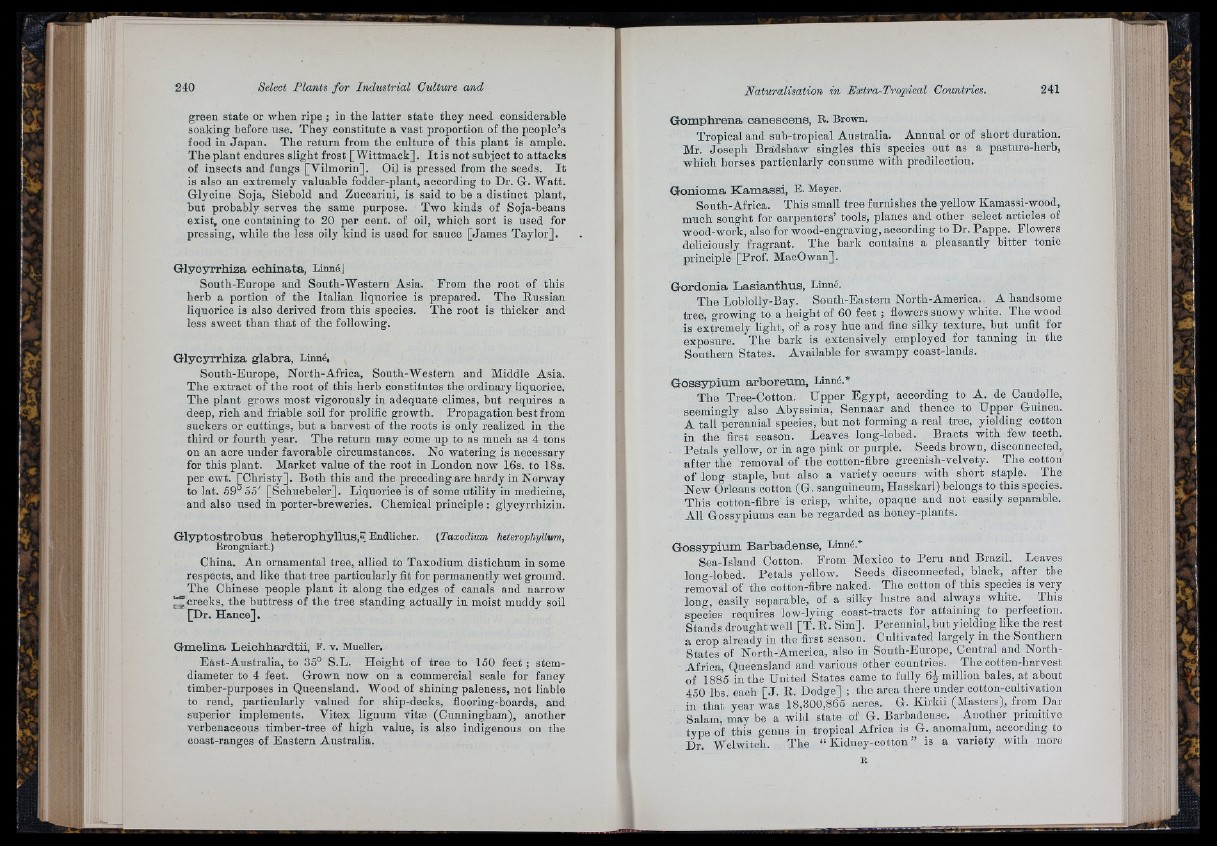
Select Plants fo r Industrial Culture and
[ i ■
green state or when ripe ; in the latter state they need considerable
soaking before use. They constitute a vast proportion of the people’s
food in Japan. The return from the culture of this plant is ample.
The plant endures slight frost [Wittmack]. I t is not subject to attacks
of insects and fungs [Vilmorin]. Oil is pressed from the seeds. I t
is also an extremely valuable fodder-plant, according to Dr. G. Watt.
Glycine Soja, Siebold and Zuccarini, is said to be a distinct plant,
but probably serves the same purpose. Two kinds of Soja-beans
exist, one containing to 20 per cent, of oil, which sort is used for
pressing, while the less oily kind is used for sauce [James Taylor].
G ly o y r r h iz a e c h in a t a , Linné j
South-Europe and South-Western Asia. From the root of this
herb a portion of the Italian liquorice is prepared. The Russian
liquorice is also derived from this species. The root is thicker and
less sweet than th a t of the following.
G ly c y r r h i z a g la b r a , Linné,
South-Europe, North-Africa, South-Western and Middle Asia.
The extract of the root of this herb constitutes the ordinary liquorice.
The plant grows most vigorously in adequate climes, hut requires a
deep, rich and friable soil for prolific growth. Propagation best from
suckers or cuttings, but a harvest of the roots is only realized in the
third or fourth year. The return may come up to as much as 4 tons
on an acre under favorable circumstances. No watering is necessary
for this plant. Market value of the root in London now 16s. to 18s.
per cwt. [Christy]. Both this and the preceding are hardy in Norway
to lat. 59° 55' [Schuebeler]. Liquorice is of some utility in medicine,
and also used iu porter-breweries. Chemical principle : glycyrrhizin.
G ly p to s t r o b u s h e te r o p h y llu s ,» Endlicher. (Taxodium heterophyllum,
Brongniart.)
China. An ornamental tree, allied to Taxodium distichum in some
respects, and like th a t tree particularly fit for permanently wet ground.
The Chinese people plant it along the edges of canals and narrow
“ creeks, the buttress of the tree standing actually in moist muddy soil
[Dr. Hance],
G m e h n a L e io h h a r d tii, P. v. Mueller.
East-Australia, to 35° S.L. Height of tree to 150 feet ; stem-
diameter to 4 feet. Grown now on a commercial scale for fancy
timber-purposes in Queensland. Wood of shining paleness, not liable
to rend, particularly valued for ship-decks, flooring-boards, and
superior implements. Vitex lignum vitæ (Cunningham), another
verbenaceous timber-tree of high value, is also indigenous on the
coast-rauges of Eastern Australia.
G o m p h r e n a c a n e s c e n s , R. Brown.
Tropical and sub-tropical Australia. Annual or of short duration.
Mr. Joseph Bradshaw singles this species out as a pasture-herb,
which horses particularly consume with predilection.
G o n iom a K am a s s i , E. Meyer.
South-Africa. This small tree furnishes the yellow Kamassi-wood,
much sought for carpenters’ tools, planes and other select articles of
wood-work, also for wood-engraving, according to Dr. Pappe. Flowers
deliciously fragrant. The bark contains a pleasantly bitter tonic
principle [Prof. MacOwan].
G o r d o n i a L a s i a n t h u s , Linné.
The Loblolly-Bay. South-Eastern North-America. A handsome
tree, growing to a height of 60 feet ; flowers snowy white. The wood
is extremely light, of a rosy hue and fine silky texture, but unfit for
exposure. The bark is extensively employed for tanning in the
Southern States. Available for swampy coast-lands.
Go s s3 7 p ium a rb o r e tiin , Linné.*
The Tree-Cotton. Upper Egypt, according to A. de Candolle,
seemingly also Abyssinia, Sennaar and thence to Upper Guinea.
A tall perennial species, but not forming a real tree, yielding cotton
in the first season. Leaves long-lobed. Bracts with few teeth.
Petals yellow, or in age pink or purple. Seeds brown, disconnected,
after the removal of the cotton-fibre greenish-velvety. The cotton
of long staple, hut also a variety occurs with short staple. 'The
New Orleans cotton (G. sanguineum, Hasskarl) belongs to this species.
This cotton-fibre is crisp, white, opaque and not easily separable.
All Gossypiums can be regarded as honey-plants.
G o s s y p iu m B a r b a d e n s e , Linné.*
Sea-Island Cotton. From Mexico to Peru and Brazil. Leaves
long-lobed. Petals yellow. Seeds disconnected, black, after the
removal of the cotton-fibre naked. The cotton of this species is very
long, easily separable, of a silky lustre and always white. This
species requires low-lying coast-tracts for attaining to perfection.
Stands drought well [T . R. Sim]. Perennial, hut yielding like the rest
a crop already in the first season. Cultivated largely m the Southern
States of North-America, also in South-Europe, Central and North-
Africa, Queensland and various other countries. _ 'The cotton-liarvest
of 1885 in the United States came to fully million bales, a t about
450 lbs each [ J . R. Dodge] ; the area there under cotton-oultivation
in that year was 18,300,865 acres. G. Kirldi (Masters), from Dar
Salam, may bo a wild state of G. Barbadense. Another primitive
type of this genus in tropical Africa is G. anomalum, according to
D r Welwitch. The “ Kidney-cotton ” is a variety with moro